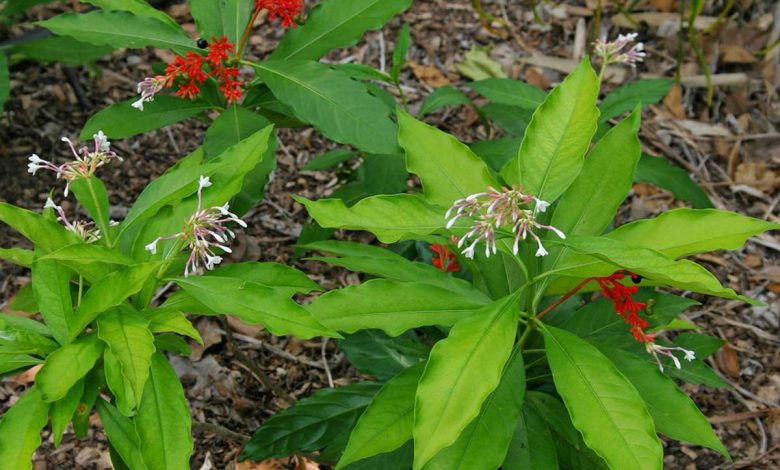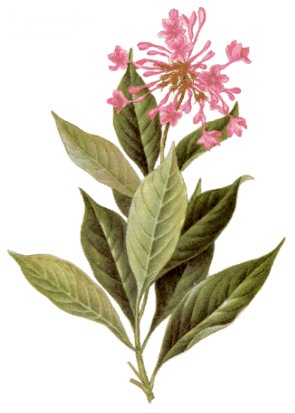Rauwolfia snake, Rauvolfia serpentina: medicines, Dosing and Administration, Contraindications

Rauwolfia serpentine is a semi-shrub, up to 1-1.5 m high, families kutrovыh (Apocynaceae). It grows in tropical countries. Harvest the roots and rhizomes, of which the medical industry produces reserpine, raunatin, aimalin.

The chemical composition of Rauwolfia serpentina
The roots and rhizomes contain about 20 indole alkaloids, that on a dry plant materials are 1-2 %. The most famous of them reserpine, rezerpinin, raupin, serpentine, rescinamin, Ajmalicine, aimalin, ajmalinin, Serpin, ioximʙin, teʙain, papaverine, etc..
Pharmacological properties of alkaloids are varied plants. Basically they affect CNS, possess hypotensive action and adrepoliticheskim, mainly due to the specific properties of reserpine and the amount close to it in the structure of alkaloids. Due to the extensive use in medical practice reserpine and total alkaloid of Rauwolfia preparations are presented below pharmacological properties of reserpine and raunatina.
Reserpine - A white crystalline powder, poorly soluble in water and well - in organic solvents. Has basically hypotensive and sedative (tranquilizing) action.
The hypotensive effect of reserpine develops slowly and lasts for a long time. The hypotensive effect is associated with a decrease in cardiac output of blood, with decreasing total peripheral vascular resistance, and the presence of the drug inhibitory effect on pressor centers. The direct effect on vasomotor Rauwolfia alkaloid centers currently not proven, since reserpine in animal does not affect the efferent impulses in pregan- glionarnyh fibers sympathetic innervation. The action of reserpine, However, nablyudayutsya bradycardia, increase in locomotor activity and secretion of the gastro-intestinal tract, and cramps, indicating that inhibition of drug-adrenergic mechanisms and the predominance of cholinergic effects.
Influence of reserpine on the CNS manifested in deepening and strengthening the physiological sleep, in potentiating the action of barbiturates and other sleeping pills and drugs, in braking reflexes interoretseptivnye, in lowering body temperature. All of this can be attributed to the category of reserpine neuroleptics. Currently, however, reserpine in practical medicine as an antipsychotic is used quite seldom.
The mechanism of action of reserpine is associated with its effect on biogenic amines, although he does not belong to inhibitors ryunoaminoksidazy. In experiments on animals when administered -alkaloida rauvolfii in high doses significantly reduced the content of biogenic amines in the central nervous system and other organs and tissues. [For Example, reduced content of catecholamines in the central nervous system, norepinephrine - in the heart muscle, vessels, the adrenal medulla.
In contrast to the individual plant alkaloid total drug from Rauwolfia serpentina raunatin - It has a softer hypotensive and sedative effect, However, due to other plant alkaloids it also had antiarrhythmic and antispasmodic properties. Despite, that the power of the hypotensive action raunatin inferior reserpine, mechanism for reducing blood pressure raunatina consists of two components - the central and peripheral rezerpinopodobnogo Adrainoliticaskie effect.
Application Rauwolfia serpentina in medicine
Formulations, Dosing and Administration
Medicine Reserpine: Dosing and Administration, Contraindications
Reserpine (Reserpine) used primarily for hypertension. Under the influence of the drug is a gradual reduction of the maximum and minimum blood pressure in various forms of hypertension (including in hyperthyroidism). The greatest effect was observed in the early stages of the disease in the absence of organic changes in the cardiovascular system. The therapeutic effect is usually 3-6 days after the start of the drug. Antihypertensive effect relatively long shelf after stopping reserpine. Assign it usually inside a pill; sometimes is administered intramuscularly or intravenously, However, parenteral administration has no significant advantages compared with the reception of the drug inside.
The dose and duration of its use should be individualized. In hypertensive disease usually begin with the appointment of reserpine at a dose of 0.1-0.3 mg / (0,0001-0.0003 G / day); take medication after eating. In some cases it is sufficient to continue to use the drug in these doses, in other cases, the dose is gradually increased to 0.5-1 mg/day; in the absence of effective dose can be increased to 1.5-2 mg/day. If within 14 days — 10 gipotenzivny effect will not come, further receiving medication overturned. If there is an effect dose gradually reduced to 0.5-0.2- 0,1 mg / day. Treatment of small (support) doses of spend long within a few months under the supervision of a physician.
You can optionally assign reserpine together with other hypotensive means, especially with apressinom, as well as geksoniem, pentaminom and other ganglioblokiruûŝimi drugs.
Reserpine applied with mild forms of heart failure with tachycardia (together with cardiac glycosides), When hypersympathicotonia, tireotoksikozah (together with tireo- static substances), in late pregnancy toxicosis.
Higher doses for adults inside rezerpina: single 0,001 g (1 mg), daily 0,01 g (10 mg). In appointing the drug in higher doses should make the indication in the recipe.
Children of reserpine administered in the age 1 year no more 0,1 mg 1-2 times a day, to 5 years - 0,1 mg 2 times a day and from 6 to 12 years - 0,1 mg 2-3 times a day.
In small doses of reserpine side effects, usually, does not cause. At higher doses and sensitivity can be observed hyperemia mucous membranes of the eyes, skin rash, stomachache, diarrhea, bradycardia, weakness, dizziness, breathlessness, nausea, vomiting, nightmares. With long-term use may phenomena parkinsonizma.
In kursovom treatment in patients with mental illnesses can develop anxiety, worry, persistent insomnia, depression.
When side effects should be reduced dose rezerpina or temporarily cancel. At pains in stomach and diarrhea appoint holinoliticaskie funds, in parkinsonizme-atropine, tropacin, amizil or similar drugs. In severe depression used stimulants of the CENTRAL NERVOUS SYSTEM. In appointing the drug on an outpatient basis should take into account the possibility of sleepiness and general weakness.
Reserpine is contraindicated heavy organic cardiovascular diseases with circulatory inefficiency and marked bradycardia, When koronaroskleroze and atherosclerosis cerebrovascular, nefroskleroze, gastric ulcer and duodenal ulcer.
Available in the form of powder and tablets 0,0001 g (0,1 mg) and 0,00025 g (0,25 mg).
Medicine Raunatin: Dosing and Administration, Contraindications
Raunatin (Raunatinum). The major indication for use is the raunatina hypertension, especially in the I and II stage. In psychiatric practice raunatin widespread use is not due to insufficient effect neirolepticski expressed, but can, However, apply with neurotic conditions.
Assign product inside tablets. Usually begin with a reception 1 tablets, contains 0,002 g (2 mg) total alkaloids, for the night; on the 2nd day take 1 tablet 2 once a day; on 3-rd day-on 3 pills and bring the total daily dose of the drug for up to 5-6 tablets per day; take raunatin after eating.
After the onset of therapeutic effect (usually 10-14 days) the dose is gradually reduced to 1-2 tablets per day. The course of treatment lasts for 3-4 weeks. However, sometimes a drug taking quite a long time in supporting the dose (1 tablet per day). Treatment should be under the supervision of a physician. At the same time with raunatinom (or sequentially) You can apply other antihypertensive, ganglioblokirute drugs, apressin, dihlotiazid etc.
Raunatin usually does not cause side effects. Some patients tolerate it better, than reserpine. However, in some cases there is a swelling of the mucous membranes of the nose, Sweating, generalized weakness; in patients with angina sometimes amplify pain in the heart. Adverse events are held at the same time reducing the dose or after a short break (1-3 Days) in preparation admission.
Medicine Aymalin: Dosing and Administration, Contraindications
Ajmalin (Ajmalinum) chemical structure refers to a group of indole derivatives and is a white or white with a slightly yellowish white crystalline powder. Very slightly soluble in water, it is difficult - in alcohol. Aymalina acetate hydrochloride and leiso soluble in water.
Aymalin unlike rezerpina lacks neuroleptic activity, moderately lowers ad, several increases coronary blood flow, provides inotropony negative effect and moderate adrepolitičeskoe activity.
A characteristic feature of antiarrhythmic properties are aymalina. It reduces anxiety attack, lengthens refrakterny period, inhibits atrioventrikuljarnuu and inside- Ventricular conduction, few oppressing automaticity sinus node, Suppresses automaticity ectopiceskih pockets in impul′soobrazovanie.
Aymalin is an effective tool for cupping the atrial fibrillation and tachycardia paroksizmalyûj. Effective for violations of rhythm, related to intoxication of drugs naperstanki.
The drug is prescribed intravenous, intramuscularly and inside; It is particularly effective when injecting introduction.
For short-acute bouts of atrial fibrillation and paroxysmal tachycardia injected 0,05 g (2 ml 2,5 % solution) in 10 ml izotoniceski solution of sodium chloride or 5 % glucose solution. Misleading slowly within 3-5 min. Optionally, you can enter during the day again 0,05 g. You can enter drug kacel′no: 2-4 Ml 2,5 % solution in a 100-200 ml izotoniceski solution of sodium chloride. Intramuscularly administered in 0,05 g (2 ml 2,5 % solution) every 8 h to 0,15 g / day (t. it is. to 3 time). If necessary, enter the drug a few days in a row.
When the therapeutic effect of Parenteral drug is transferred to the inside of 1-2 tablets (0,05-0.1 g) 3-4 Times daily (within 1-3 weeks). Aymalin usually well tolerated. Certain patients indicated hypotension, generalized weakness, nausea, vomiting; through intravenous feeling heat.
Contraindications (especially for intravenous injection): the heavy defeat of the conducting system of the heart, highly pronounced sclerotic and inflammatory changes infarction, circulatory insufficiency III stage, sudden hypotension. Caution is needed in the case of patients with fresh aymalina myocardial infarction: possible demotion ad and violation of conductivity.
